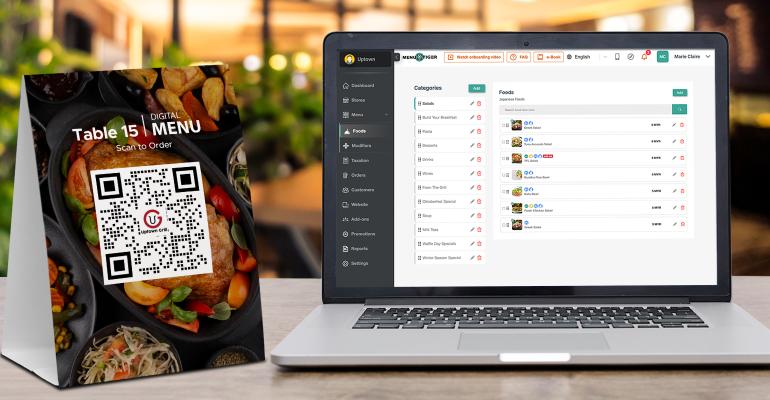Sponsored by QRTIGER
It’s no secret that younger diners find using a digitized QR code menu a positive experience.
But why are there still popular opinions against an efficient and well-meaning QR code menu?
Most of this resistance, unsurprisingly, are from “boomers” or traditional diners who would much rather get handed a physical menu—the less tech-savvy set who are not used to zooming in and out of unappealing black-and-white QR codes.
And we can’t blame them.
But a QR code menu is not here to abolish physical menus. If anything, they’re a ‘smart’ addition to meet growing customer demands and tightening budgets.
There’s no denying that QR code menus have helped the restaurant industry through the pandemic. And with the looming recession, it’s best to invest in an advanced digital menu that can withstand the economic ebb and flow, short-staffing, and the overall competitive market.
Upholding employees despite labor shortage
Your service is only as good as the well-being and enthusiasm of your staff. Are they happy, or constantly overworked?
But… how do businesses find that balance with constant staff shortages?
Even as 56% of restaurant managers offered higher wages in the second quarter of 2022, labor shortage persists.
Because of this, 8 in 10 operators say using technology makes them more competitive. Now more businesses are investing in software.
It’s all about long-term solutions to adapt better and ease the team’s workload.
"[A QR Code menu] gives us the flexibility to be hospitality professionals as opposed to order takers," says Aimee Arcilla, General Manager and Wine Director at Good Good Culture Club for Food & Wine.
This people-first approach cultivates better customer service even on the busiest days. “Using the QR system allows us as staff more time [to] interact with the guests and have real conversations,” says Good Good Culture Club server Nora Barber for Bon Appétit.
Easy menu curation and ordering system
A smart QR code menu includes a drag-and-drop feature to add high-quality photos and modifications. No coding required, even when setting up holiday themes and special events. It can also set food specials at certain hours of the day.
Customers can check offers beforehand, and set a reservation on the same page.
The PYMNTS Restaurants Digital Divide research found that twice as many customers prefer to order on restaurants’ own apps and websites when dining in. Add promos, discounts, and bundles to create positive feedback loops and keep them coming back.
Future-proofing
The realities of day-to-day operations call for a software that would allow advanced order features, mobile payments, and a reduction of ordering mistakes.
Due to inflation, the produce prices could increase at a moment’s notice. Menu price changes can be easily updated across all branches within a single software. No need to print a series of physical menus every time.
Intro to data tracking
“Data-driven organizations are 23 times more likely to acquire customers, 6 times as likely to retain customers, and 19 times as likely to be profitable as a result.”
Restaurants can start getting first-party data by tracking their bestsellers and least ordered items on the menu. It helps to understand why some items are performing or underperforming, so businesses can adjust accordingly.
The rise of pay-at-the-table technology
How convenient is it to settle bills right on your smartphone? That’s the beauty of pay-at-the-table solutions such as menu QR codes.
“Investing in digital menu software and self-pay technology increases a business’ resilience.” says Benjamin Claeys, CEO and founder of QR code generator QRTIGER and restaurant software MENU TIGER. “They’re no longer at the mercy of sudden price increases, and staff availability.
“Customers are given more autonomy in their ordering and payment experience,” he continues. “The staff are not limited to order-taking, and can focus on more important tasks.”
Turn of the tide
The constant improvement of Menu QR Codes makes them the more low-cost and practical solution for an industry that’s grappling with erratic post-pandemic adjustments, and ever-changing demands of the market.
They’re here to stay as they cater to the more tech-savvy and on-the-go customers.
As Claeys aptly stated, "No matter the criticisms against QR code technology, restaurants will still need to adapt based on the customers’ changing needs. There has been much resistance to the shift from newspaper to online media back in the day, but that didn’t stop major publications from evolving and growing into what they are now.
“It’s the same for QR code menus. Restaurant managers will need to invest in a reliable digital menu to cater to the growing needs of their customers. This will keep them ahead of the competition, and help build a solid foundation amid current economic changes.”
MENU TIGER is one reliable QR code menu and payment software that offers the flexibility that restaurants need. Other than their no-code menu curation, they also have easy Canva integration, multi-language translations, and Wi-Fi QR codes.
Explore a more advanced QR code ordering system with a free trial of their premium plan today




